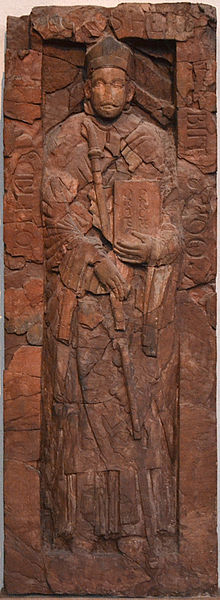Gottfried von Spitzenberg
Gottfried I. von Spitzenberg (lat. Gottfridus I de Pisenberg ; * 1132 ; † July 8, 1190 in Antioch ) was a close confidante of the Hohenstaufen emperor Friedrich I (Barbarossa) and bishop of Regensburg and Würzburg .
origin
Gottfried I came from the house of Sigmaringen - Spitzenberg . He was the son of Rudolf I of Sigmaringen and Spitzenberg (exp. 1133 to 1147) and an Adelheid. His brother, Ludwig III. von Sigmaringen and Spitzenberg (adult 1147 to 1200), married the daughter or sister of Eberhard the Younger von Helfenstein , who remained without a male successor, and from then on called himself Ludwig I. von Helfenstein. Gottfried's second brother was Ulrich (adult 1174). The Sigmaringen-Spitzenberg line was created through the marriage of Ludwig I the Elder of Sigmaringen (adult 1083; † before 1092) and Richinza, the heiress of Spitzenberg, daughter of Berthold I of Zähringen , the Duke of Carinthia from 1061 to 1077 and Margrave of Verona.
Career
Gottfried I. studied law in Bologna and theology in Paris. In 1172 he became canon in Würzburg and imperial court chancellor at Barbarossa. In the following years he took part in the 5th Italian campaign against the Lombard cities and was instrumental in the conclusion of the Peace of Venice in 1177 . 1184–85, Gottfried exercised the office of General Legate in Italy in addition to the Chancellery. On June 18, 1185 he was elected Bishop of Regensburg . In the following year, the Würzburg bishop Reginhard von Abenberg died . Gottfried was elected his successor and thus retired from the imperial service.
Bishop of Würzburg
In 1187 the Muslim sultan Saladin succeeded in the battle of Hattin in destroying the Christian army of the crusader states in Palestine . Emissaries of the Pope reported on the court meeting in Strasbourg about the loss of Jerusalem and called for the reconquest of the holy places. In 1188 at the Court Day of Jesus Christ in Mainz - not least because of Gottfried's sparkling eloquence - it was decided to gather a crusade army in Regensburg the following year in order to recapture the Holy Land. The army, which Gottfried also joined, had crossed the Balkans and crossed Asia Minor against fierce resistance when Emperor Barbarossa drowned in the Saleph River in 1190 . Subsequently, in Antioch, many of the crusaders fell ill with an illness; Gottfried also died from it.
Before his death, Gottfried had determined that his right hand should be brought to Würzburg. So the hand was cut off the body and sent on the journey to Würzburg. The messengers were presumably attacked by robbers on the way, who suspected valuable objects in the cassette they were carrying. In any case, the hand was lost on the way and so today only the grave slab of Bishop Gottfried I stands in the Würzburg Cathedral . It is the oldest preserved grave slab in Kilians Cathedral. The visitor will find it on the second pillar of the northern, in the view on the left, tall nave wall.
literature
- Peter Kolb and Ernst-Günther Krenig (eds.): Lower Franconian history. Würzburg 1989, pp. 348-349.
- E. Bünz: From Swabia to Antioch. The Würzburg bishop Gottfried von Spitzenberg (1186-1190). Hohenstaufen / Helfenstein. Historical yearbook for the Göppingen district 17, 2007, 9–50.
- Theodor Henner: Gottfried I., Bishop of Wirzburg . In: Allgemeine Deutsche Biographie (ADB). Volume 9, Duncker & Humblot, Leipzig 1879, p. 477 f.
- Alfred Wendehorst: Gottfried I. Graf v. Spitzenberg-Helfenstein. In: New German Biography (NDB). Volume 6, Duncker & Humblot, Berlin 1964, ISBN 3-428-00187-7 , p. 667 f. ( Digitized version ).
- Marcus Wüst: Gottfried von Spitzenberg-Helfenstein. In: Biographisch-Bibliographisches Kirchenlexikon (BBKL). Volume 32, Bautz, Nordhausen 2011, ISBN 978-3-88309-615-5 , Sp. 519-521.
Web links
| predecessor | Office | successor |
|---|---|---|
| Konrad II of Raitenbuch |
Bishop of Regensburg 1185–1186 |
Conrad III. of Laichling |
| Reginhard von Abenberg |
Bishop of Würzburg 1186–1190 |
Philip of Swabia |
| personal data | |
|---|---|
| SURNAME | Gottfried von Spitzenberg |
| ALTERNATIVE NAMES | Gottfried I. von Spitzenberg-Helfenstein; Gottfried of Regensburg; Gottfried I of Würzburg; Godfridus I de Pisenberg |
| BRIEF DESCRIPTION | Bishop of Würzburg |
| DATE OF BIRTH | 1132 |
| DATE OF DEATH | July 8, 1190 |
| Place of death | Antioch |
